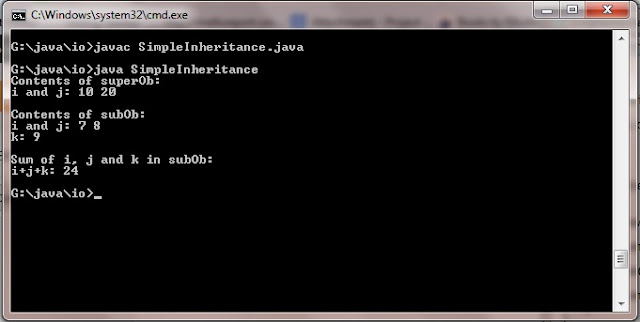Inheritance is a major component of object-oriented programming. Inheritance will allow you to define a very general class, and then later define more specialized classes by simply adding some new details to the older more general class definition. This saves work, because the more specialized class inherits all the properties of the general class and you, the programmer, need only program the new features.
For example, you might define a class for vehicles that has instance variables to record the vehicle's number of wheels and maximum number of occupants. You might then define a class for automobiles, and let the automobile class inherit all the instance variables and methods of the class for vehicles. The class for automobiles would have added instance variables for such things as the amount of fuel in the fuel tank and the license plate number, and would also have some added methods. (Some vehicles, such as a horse and wagon, have no fuel tank and normally no license plate, but an automobile is a vehicle that has these "added" items.) You would have to describe the added instance variables and added methods, but if you use Java's inheritance mechanism, you would get the instance variables and methods from the vehicle class automatically.
To inherit a class, you simply incorporate the definition of one class into another by using the extends keyword. To see how, let's begin with a short example. The following program creates a superclass called A and a subclass called B. Notice how the keyword extends is used to create a subclass of A.
Program
class A
{
int i, j;
void showij()
{
System.out.println("i and j: " + i + " " + j);
}
}
class B extends A
{
int k;
void showk()
{
System.out.println("k: " + k);
}
void sum()
{
System.out.println("i+j+k: " + (i+j+k));
}
}
class SimpleInheritance
{
public static void main(String args[])
{
A superOb = new A();
B subOb = new B();
superOb.i = 10;
superOb.j = 20;
System.out.println("Contents of superOb: ");
superOb.showij();
System.out.println();
/* The subclass has access to all public members of
its superclass. */
subOb.i = 7;
subOb.j = 8;
subOb.k = 9;
System.out.println("Contents of subOb: ");
subOb.showij();
subOb.showk();
System.out.println();
System.out.println("Sum of i, j and k in subOb:");
subOb.sum();
}
}
For example, you might define a class for vehicles that has instance variables to record the vehicle's number of wheels and maximum number of occupants. You might then define a class for automobiles, and let the automobile class inherit all the instance variables and methods of the class for vehicles. The class for automobiles would have added instance variables for such things as the amount of fuel in the fuel tank and the license plate number, and would also have some added methods. (Some vehicles, such as a horse and wagon, have no fuel tank and normally no license plate, but an automobile is a vehicle that has these "added" items.) You would have to describe the added instance variables and added methods, but if you use Java's inheritance mechanism, you would get the instance variables and methods from the vehicle class automatically.
To inherit a class, you simply incorporate the definition of one class into another by using the extends keyword. To see how, let's begin with a short example. The following program creates a superclass called A and a subclass called B. Notice how the keyword extends is used to create a subclass of A.
Program
class A
{
int i, j;
void showij()
{
System.out.println("i and j: " + i + " " + j);
}
}
class B extends A
{
int k;
void showk()
{
System.out.println("k: " + k);
}
void sum()
{
System.out.println("i+j+k: " + (i+j+k));
}
}
class SimpleInheritance
{
public static void main(String args[])
{
A superOb = new A();
B subOb = new B();
superOb.i = 10;
superOb.j = 20;
System.out.println("Contents of superOb: ");
superOb.showij();
System.out.println();
/* The subclass has access to all public members of
its superclass. */
subOb.i = 7;
subOb.j = 8;
subOb.k = 9;
System.out.println("Contents of subOb: ");
subOb.showij();
subOb.showk();
System.out.println();
System.out.println("Sum of i, j and k in subOb:");
subOb.sum();
}
}
Output
G:\>javac SimpleInheritance.java
G:\>java SimpleInheritance
Contents of superOb:
i and j: 10 20
Contents of subOb:
i and j: 7 8
k: 9
Sum of i, j and k in subOb:
i+j+k: 24

0 comments:
Post a Comment